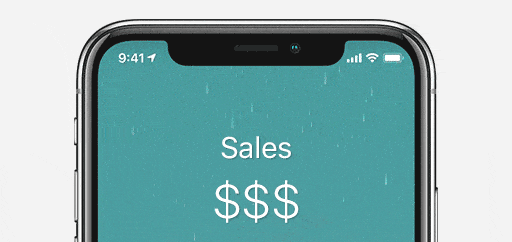The tiniest drop in temperature (1.8°F to be specific) can cause a 25% increase in mousetrap sales. One snowfall can cost a restaurant $6000 in lost sales, a 68°F increase in temperature can lead to an almost 10% jump in convertible car sales, and when spring temperatures hit 70°F, sales of hair removal products increase by an astounding 1400%.
Experts say the weather can impact one’s willingness to pay, their decision-making abilities and, more obviously, the things they buy.
Research shows eCommerce websites can experience low traffic during stints of good weather, while physical retail shops see more foot traffic.
People have predictable moods and behaviors that correlate with the weather, and marketers can win by exploring how their products and services fit into all of this.
Summertime & supermarkets 🛒
Psychologists have long known about the effects of weather on mood, and retailers like supermarkets wasted no time using this knowledge to their advantage. Tesco, the largest supermarket chain in Britain, found when weather increased by 18°F, their sales of barbecue meat tripled, and demand for lettuce went up by 50%.
Walmart studies relationships between sales and weather and launches complementary campaigns to specific ZIP codes. By analyzing historical weather data in select areas, the grocery giant found that sunny blue skies with temperatures of 75°F means people will react positively to sales incentives and ads for berries. They roll out new strawberry ads to mobile phones in areas with this forecasted weather.
Sunny splurging; weather-driven demand 📈
Research shows sun exposure can trigger the body to produce serotonin through the skin. Serotonin is a chemical responsible for regulating mood, and a deficiency in this compound could cause a low feeling. So why should marketers care about this? This sunshine effect could explain why consumer willingness to pay (WTP) is significantly higher during sunny weather compared to days with overcast. Psychologists aren’t shocked to hear this, as their findings show relaxed or happy consumers spend the most money. In particular, sunshine and one’s sports team winning can significantly increase the amount they pay.
And if that wasn’t convincing enough, additional research suggests that unexpected sunshine can cause people to buy more expensive products than they usually would. Sunbathers beware!
Consumer behavior explained 🌧
Brick-and-mortar retailers see dollar signs when their weather app calls for sunshine, but what about online retailers? Research shows during sunny weekends, people shop online less. Online sales tend to decrease during sunshine-filled days, and when it’s all overcast, social media engagement is roughly 42% higher. Generally, people are online less when the weather is ideal.
Even the world’s largest online retailer is not immune to weather-related sales dips. Think about it, it’s no coincidence Amazon’s largest sale of the year, Prime Day, takes place during prime sunshine time, mid-July.
Weather-based marketing 🌦️
So, it’s sunny outside, and you’re a digital marketer or an online retailer. How do you make up for the lack of engagement and traffic?
Retail experts say hot weather is a needs driver versus a wants driver. Specific goods can fly off the shelves in the summer; sunglasses, bottles of water, sunscreen, etc. Now even if you don’t sell beach bag essentials, you can market your products or services around the weather, as it’s topical, relevant and could build trust with your customers. You just have to think outside the box a little and determine how your products or services can sell by leveraging the weather.
Big brands rollout weather campaigns
When you first meet someone, crutching onto conversations about the weather can be a great way to avoid traumatic, social awkwardness! The same applies to marketing and advertising.
When serving ads to a new audience, understand that there will be some skepticism. Leading with the weather in your copy or imagery can build trust right off the bat. Not to mention, timeliness and sense of urgency can help with click-through rates on ads. And if the weather is what’s on people’s minds, it’s time you capitalize on that, which is what the shampoo brand Pantene did.
In 2013, the P&G owned hair-care brand was facing significant problems. The hair care space in the US was becoming saturated. Pantene didn’t have any new products in development and customers were quick to leave them for a shiny new competitor. Not to mention their largest national retailer (Walgreens) took notice and was ready to cut the cord. They needed a new way to capture the market, and ‘weather’ was the winning ticket.
The P&G brand partnered with The Weather Channel to market specific products to potential consumers based on their local weather forecasts. Their ‘haircasts’ initiative would serve weather-dependent product recommendations based on the Weather Channel’s forecasts.
If the weather channel was reporting high humidity in Chicago, for example, their marketing team queued up the ‘humidity’ campaign complete with anti-frizz product recommendations, copy and CTA’s all relevant to the forecast. Just as the weather changed, so did their ads. Moisturizing oils and conditioners were targeted to folks in Midwest states during dry, hot periods and viewers were given $2 off coupons to incentivize purchases at the retail level.
As the shampoo company gathered intel, they pinpointed their top-performing ads and did what they do best, rinsed and repeated. The winning ads were served to segmented groups in areas with similar forecasts.
By using this weather marketing strategy, Pantene was able to increase its sales by 28% and keep its biggest retailer happy.
You don’t have to be a haircare brand to benefit from weather marketing. Stella Artois reported a 65% increase in YOY sales during the period they ran a weather-responsive advertising campaign. Urban Outfitters and Dunkin Doughnuts used mobile push notifications to target loyalty members who were experiencing considerable snowfall. DD encouraged customers to come into stores with a coupon, and UO acknowledged that people were likely ‘snowed in’ and should shop via their app. Personalizing ads and empathizing with what people are experiencing can help build trust.
According to a 2016 survey, over 70% of consumers say they prefer personalized ads. Because weather marketing requires accurate, real-time information, there is a significant element of personalization involved. The ad recipient will feel that connection.
How to get started with weather marketing
If it sounds like your product or service would benefit from weather-related marketing initiatives, there’s no need to wait for a snowstorm or a drought to get started:
- Start strategizing: Understand how specific weather conditions will help you market your products. Depending on what you sell, this might be tricky. Put yourself in your customer’s shoes. How are they feeling during a heatwave? How can you empathize with them while offering them a product that will improve their day? Give them what they want. Come up with strategies for different forecasts and complementary products or services. Tip: When strategizing around weather, don’t just think within the confines of sunshine and clouds; weather impacts allergies, vitamin deficiencies, bug bites and travel.
- Create the content: Visuals and copy should coincide with the weather. Ensure you have options for all kinds of forecasts that will help sell your products, as they might have to get switched out on a moment’s notice!
- Geo-targeting: Geo-targeting is the optimal way to target customers precisely in specific geographical locations. You can enable geo-targeting in Google AdWords, Facebook, and MailChimp. Say you heard that Portland had an unexpected snowfall, you can set up a geo-targeting audience and sell them a product that might make their snow day a little more cozy and comfortable. The same goes for the folks in Nevada facing the hottest spring on record. Facebook will let you target ads to people who live in/were recently in/or who will travel to the selected location. These applications open up your weather marketing possibilities further.
- It takes time: Thought it would be as easy as selling snow cones on a scorching afternoon? Think again. Depending on how much historical sales data you have, it could take some time to see what weather strategy works for you. The arts and crafts retailer Michael’s had a hunch that people enjoyed DIY projects and crafts more during rainy weekends than sunny ones. Their intuition was spot on, but sending out promos on rainy days didn’t prove to be very successful. After reviewing their analytics, they tried starting their campaigns earlier. This shift allowed them to find their magic number; ramping up advertising three days before a rainy weekend proved to boost sales substantially.
- The data doesn’t lie: By cross-referencing sales data with historical weather information, you will hopefully see patterns. From there, you can take a page out of Pantene’s book, rinse and repeat to see if what once worked will work again.
More relevant and timely marketing can lead to lower cost per acquisition. And now that we know the weather is both relevant and timely to customers, this could be your secret sauce when developing future campaigns. All that’s left is finding a reliable meteorologist.






